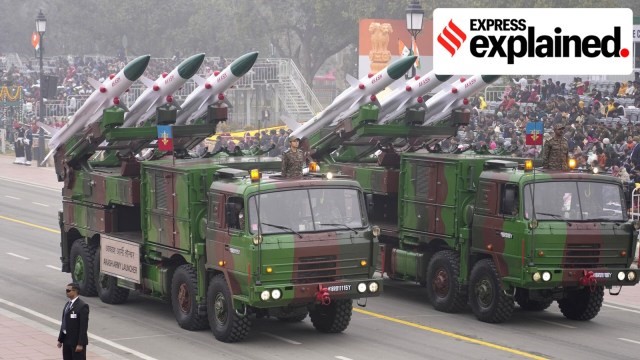Operation Sindoor

- 18 May 2025
In News:
Operation Sindoor marked a significant leap in India's military and technological prowess, not only achieving its strategic objectives but also demonstrating the operational maturity of Made-in-Indiadefence systems. The operation was characterised by a multi-layered approach involving precision strikes, air defence, unmanned systems, and advanced surveillance tools—most of which were indigenously developed.
Precision and Navigation Capabilities
One of the defining features of Operation Sindoor was the pinpoint accuracy of strikes deep inside Pakistan and Pakistan-occupied Kashmir. Specific terrorist camps and infrastructure were destroyed with minimal collateral damage, underlining India’s commitment to responsible military engagement. This precision was enabled by a combination of advanced guidance systems and real-time data from space-based and ground-based assets.
India's indigenous Navigation with Indian Constellation (NavIC) system, offering positional accuracy of 10–20 cm, played a pivotal role. High-resolution satellites such as Cartosat, RISAT, and EOS provided real-time imagery, allowing sub-metre targeting. These capabilities are a result of sustained investments by DRDO and ISRO and reflect the prioritisation of guidance and navigation as a critical technology domain in DRDO’s 2023 R&D roadmap.
Lethality and Advanced Weapon Systems
The destruction caused during Operation Sindoor also demonstrated the high lethality of Indian weapon systems. Deep penetration warheads, advanced fusing mechanisms, and powerful propulsion systems—developed under the Integrated Guided Missile Development Programme—were central to the operation’s success. The likely use of the BrahMos missile, equipped with state-of-the-art guidance and propulsion, underscores the maturity of indigenous missile technology.
Emerging technologies such as Directed Energy Weapons (DEWs), including laser-based systems, were reportedly deployed to neutralise incoming drones. DEWs have been a priority sector for the Defence Ministry since 2022, and DRDO showcased them during the 2025 Republic Day Parade.
Integrated Air Defence and Radar Systems
A critical success factor in Operation Sindoor was India’s ability to neutralise almost every aerial threat, including drones and missiles. This was achieved through a combination of imported and indigenous systems. The S-400 Triumph, along with DRDO-developed radars like Rajendra, Rohini, LLTR, and low-level 3D radars, formed a robust air defence network. These systems enabled accurate detection, tracking, and interception of aerial threats.
Cutting-edge R&D continues in radar technologies, including AI-powered signal processing, stealth detection, and foliage-penetrating radars, which will further enhance India’s battlefield awareness and response capability.
Role of Unmanned Systems
For the first time in an India-Pakistan conflict, drones played a decisive role. Indian UAVs executed deep strikes into Pakistani territory, while enemy drone swarms were largely neutralised. India also deployed upgraded Bofors guns and SAMAR systems to counter low-flying threats. The success of unmanned platforms indicates a paradigm shift towards hybrid warfare, with manned-unmanned teaming becoming a future norm.
However, to sustain this capability, India must strengthen its domestic manufacturing base, ensure secure raw material supply chains, and foster collaboration between industry, academia, and the armed forces.
Conclusion:
Operation Sindoor represents a watershed moment in India’s defence preparedness. It validated years of indigenous R&D and affirmed India’s self-reliant defence posture. As warfare evolves, India’s ability to synergise space, cyber, and kinetic capabilities with unmanned platforms will be critical in ensuring strategic deterrence and national security.
Operation Sindoor and the Emerging Imperative of Digital Warfare in India’s National Security

- 12 May 2025
In News:
On May 7, India launched Operation Sindoor, targeting terrorist bases in Pakistan in response to the Pahalgam terrorist attack on April 22. This military action quickly became a case study in how modern warfare extends beyond physical battlegrounds to include digital and information domains.
Managing Information During Conflict
Following the operation, India’s Ministry of Defence issued an advisory on May 9 urging media, digital platforms, and individuals to avoid live or real-time reporting of military movements. The Press Information Bureau (PIB) also stressed sharing only official updates to counter the spread of misinformation. This advisory was crucial after fake news, including false claims that the INS Vikrant aircraft carrier attacked Pakistani ports, spread rapidly on social media and TV channels. The misinformation originated from a fraudulent social media account pretending to be the INS Vikrant, causing panic and confusion, which was then amplified by Pakistani sources.
Hybrid Nature of Modern Conflicts
Modern conflicts have evolved into “hybrid wars” that combine traditional military operations with sophisticated information warfare. Research from King’s College London highlights how states use both traditional and social media platforms for “perception management”—influencing public opinion to strengthen domestic support or destabilise opponents. In such environments, misinformation spreads rapidly due to media pressure to break news first, public anxiety seeking instant updates, and social media algorithms that prioritise sensational content regardless of accuracy.
Cyber Warfare: The Invisible Battlefield
Digital warfare also includes cyberattacks on critical infrastructure and military networks. Since the Pahalgam attack, India has faced several cyber intrusions originating from Pakistani and spoofed networks. Cyber operations now run parallel to physical conflicts, forming a multi-domain battlespace where controlling information flow and disrupting enemy networks are as vital as territorial gains.
Recent global examples include Russia’s cyberattacks on Ukraine during the 2022 invasion and retaliatory cyber operations by Ukrainian hackers. Similarly, after Hamas’s October 2023 attack, Israel faced massive cyber assaults and widespread disinformation campaigns on social media using AI-generated content.
Challenges in Cyber Conflict
Cyber warfare is especially challenging because attacks are remote, anonymous, and difficult to attribute. Attackers hide behind proxies and compromised systems, complicating diplomatic responses and exposing gaps in international laws governing cyber conflicts. As tensions rise, India may encounter more frequent and sophisticated cyberattacks targeting its infrastructure, military communications, and financial systems, alongside conventional military threats.
India’s Preparedness Strategy
To tackle these challenges, India must adopt a comprehensive strategy combining legal, diplomatic, and technological measures:
- Legal: Strengthen cybersecurity laws under the Information Technology Act and push for international agreements to regulate state-sponsored cyberattacks.
- Diplomatic: Enhance cooperation in global forums like the UN Group of Governmental Experts (GGE) and partner with technologically advanced nations to identify and counter hostile cyber activities.
- Technological: Invest heavily in cyber defence and offence capabilities. Critical infrastructure must be fortified through security audits, network segmentation, and resilient backups. Agencies such as the National Critical Information Infrastructure Protection Centre (NCIIPC) and CERT-In need enhanced capacities to detect and respond to threats. Regulators should promote continuous network monitoring and public awareness on cybersecurity, exemplified by the Reserve Bank of India’s directives to banks.
Conclusion
The digital battlefield—comprising misinformation and cyberattacks—demands a coordinated government response and active citizen engagement. As conventional and digital warfare increasingly overlap, India’s national security depends on not only military preparedness but also information resilience and cybersecurity. With well-planned, multi-dimensional strategies, India can effectively confront emerging digital threats and secure its sovereignty in an increasingly complex geopolitical environment.
